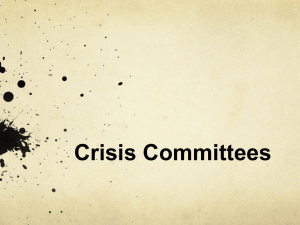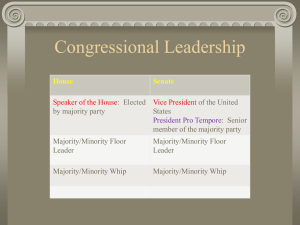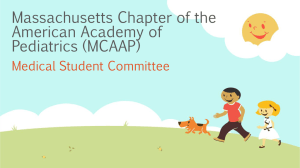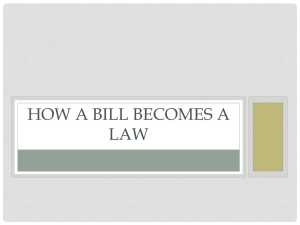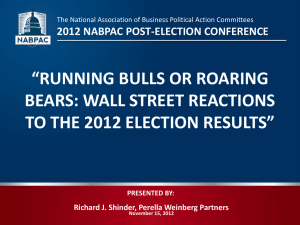The National Committees
advertisement
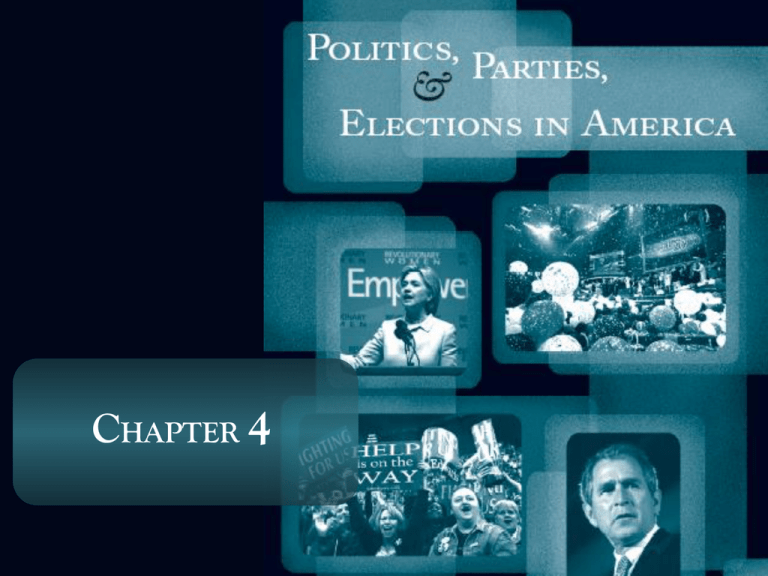
CHAPTER 4 Party Organizations Party organization in the United States exists in a great variety of forms, and the type of organization depends upon a variety of factors: the level of government involved (e.g. local, state, or national) the type of governmental regulations under which it must operate the extent of interparty competition that exists the clientele or bases of party support regional and local traditions the nature of the electorate Party Organizations Generally American political parties are cadre parties rather than mass membership parties Cadre parties are characterized by a small number of leaders and activists who maintain the organization, recruit candidates, seek to influence nominations, and campaign for the party’s nominees The American cadre type party is organized to carry out its primary task—the winning of elections Therefore, party organization is built around geographic election districts, starting with the basic unit of election administration, the precinct Party organization can be described as a system of layers of organization (Figure 4.1.) Figure 4.1. Layers of Party Organization in the United States Congressional Campaign Committee National Committee and Chair/Headquarters Staff Senatorial Campaign Committee State Senate Campaign Committee State Committee and Chair/Headquarters Staff State House of Representatives Campaign Committee Congressional District and State Legislative District Committees County Committees (Townships in Northeast; Parishes in Louisiana; Districts in Alaska) Rural Areas Town, Village Rural Township Committees Urban Areas City Committee Ward Committee Precinct Leaders Party Organizations This layered organizational structure is called stratarchy, “an organization with layers, or strata, of control rather than centralized leadership from the top down.” A special component of stratarchy is reciprocal deference, which means that there is a tolerance of autonomy between the layers of organization The loosely structured system of formal party organization is supplemented by individual candidate organizations, party-allied groups, and campaign consultants Together they form a network The National Parties The National Committees Represent the party organizations of the fifty states plus ex officio representation for important elected officials and organized interests The national committee can be an effective catalyst for stimulating the party organization, even though its formal powers are limited The RNC and the DNC differ in their degrees of institutionalization and professionalization, which is reflected by differences in party receipts (Figure 4.2.) Figure 4.2. National Party Receipts, 1976-2004 (Combined Receipts of National, Congressional, and Senatorial Committees in Millions) Party Receipts (in Millions) 700 657.1 600 576.2 500 400 347.8 321.2 300 245.9 191.4 192.1 200 207 120.4 164.9 100 43.1 15.1 0 1976 20 1980 65.9 1984 81.1 1988 Democratic Committees Source: Federal Election Commission 104.1 1992 1996 Republican Committees 2000 2004 The National Parties The National Chairs Because the national committees are unwieldy in size and only meet twice a year, the national chair plays a key role in determining how the committee will operate The national chairs serve on a fulltime basis, and their job is to create a headquarters capable of providing the services needed to win elections Frequently, a major responsibility of the national chair is maintaining or restoring a sense of party unity, through mediation among various factions Generally the chair of the party that controls the White House has less flexibility and independence than the chair of the opposition party The National Parties The actual work of the national committees includes: Fund-raising of “hard money”—funds raised in accordance with Federal Election Campaign Act (FECA) restrictions Assistance to state and local party organizations Campaign activities, such as supporting the presidential nominees’ campaigns Communications, such as campaign advertising Planning, and managing the national conventions Research to provide issue background to candidates and party leaders The National Parties Party Integration in Election Campaigns Large-scale transfers of party funds from the national committees to state parties were previously encouraged by provisions of the FECA After the Bipartisan Campaign Reform Act (BCRA) of 2002, party spending went through a number of changes which profoundly affected party organizations: - national parties raised more hard money transfers to state parties declined state parties did not advertise parties continued to make strategic transfers Figure 4.3. State Expenditures, 2000 and 2004 300 Millions Spent 250 200 150 100 50 0 Media Grassroots Mobilization 2000 Administration Unidentified 2004 Source: Raymond J LaRaja, “State and Local Parties,” in Michael J. Malbin, ed., Election after Reform: Money, Politics, and the Bipartisan Campaign Reform Act (Lanham, MD: Rowman & Littlefield, 2006). Figure 4.4. National-to-State Party Transfers, 2003-2004 Transfers to States by DNC and RNC More than $2,000,000 (11) $1,000,000 to $2,000,000 (11) $200,000 to $1,000,000 (14) $0 to $200,000 (14) Source: Federal Election Commission The National Parties The Hill Committees Congressional and senatorial campaign committees (“Hill Committees”) are increasingly important elements of the national party The members of these committees are members of the House and Senate The Hill committees focus on holding their parties’ marginal seats by assisting targeted candidates Through coordinated expenditures, the hill committees are also permitted by the FECA to make expenditures in support of their parties’ candidates Figure 4.5. Allocations of National Party Funds in U.S. House and Senate Elections, 2002: Concentrating on Competitive Races Where There Is a Chance to Win 100% 100% Percent Allocated 90% 90% 80% 80% Open Seat Candidates With Little Chance Open Seat Candidate with 70% 70% Challengers With Little Chance Little Chance 60% 60% SafeChallengers Incumbents 50% 50% Safe Incumbents Strong Open Seat Candidates 40% 40% Strong Open Strong Challengers 30% 30% with Little Chance Seat Candidates Strong Challengers Vulnerable Incumbents 20% 20% Vulnerable Incumbents 10% 10% 0% 0% House House Senate Senate House House Senate Senate Democrats Republicans Democrats Republicans Democrats Republicans Democrats Republicans Percent Allocated Source: Adapted from Federal Election Commission data analyzed by Paul S. Herrnson, Congressional Elections: Campaigning at Home and in Washington, 4th ed. (Washington, D.C.: CQ Press, 2004), p. 101. The National Parties Party-Allied Groups In addition to the formal, legally constituted party organizations such as the national or the hill committees, the organizational resource base of the parties also includes other organizations Traditionally, the Democratic Party has had a strong connection to labor unions, whereas the Republican Party had a strong connection to corporations In recent elections, party-allied groups, often with interest in special issues, have been extensively involved in campaigns However, these groups have their own agenda, and maintain an autonomous organizational structure The National Parties “Think Tanks” and Consultants Yet another addition to the formal, legally constituted party organizations is the Washington public-policy research organizations called “think tanks” These are an important source used for the formulation and promotion of policy proposals Political consultants have also become a prominent element in the structure of the party organizations To win elections, party organizations need the technical/professional skills and the personalized State Parties There is a tendency in the United States for extensive statutory regulation of parties by the states, with great variation among states The legal position of state parties has much in common with that of public utilities, as they perform essential public functions under the protection of the law The legal position of the parties is in the process of modification as a result of a series of recent Supreme Court decisions State Parties The State Committees In each of the states there is a Republican and Democratic state committee, the members of which may represent counties, congressional districts, legislative districts or party auxiliary groups Because the size of state committees is often unwieldy and their meetings infrequent, many state parties rely heavily upon an executive committee The responsibilities of the state committees include overseeing the work of the state chair and the headquarters staff, calling of state conventions, adopting party policies, supervising platform drafting, fundraising, and assisting candidates State Parties The Role of the Governor In a nationwide study, most state party chairs considered the governor’s role in party affairs to be advisory rather than controlling In some states, however, the governor plays a substantial role in the selection of their party’s state chair Most commonly the governor and state chair consult on appointments, candidate recruitments, fundraising, and other major party activities State Parties The Service-Oriented State Organization of the 2000s To survive and perform a meaningful role in current state politics, the parties had to adapt to an environment characterized by: - an absence of large-scale patronage candidate-centered campaigns heightened interparty competition for statewide offices strengthened national party organizations In adapting to these conditions, the state party organizations have become service agencies to their candidates and local affiliates State Parties Among the indicators of the evolution of most state parties into service organizations are: - the establishment of permanent headquarters the increased use of professional staffing significant expansion of state party budgets the expansion of party programs for support of candidates and party building Studies of state party organization have shown that on the whole Republicans tend to have stronger, more professionalized, and better-financed state organizations than the Democrats State Parties State Legislative Campaign Committees These increasingly important organizations are fashioned after congressional and senatorial campaign committees at the national level They are composed of incumbent legislators who raise funds and hire staff to assist their parties’ legislative candidates The most active legislative campaign committees are found in states with high levels of interparty competition, high campaign costs, and weak state central committees County and Local Parties The Party Machine The most familiar type of local party organization is the big city machine (e.g. the Cook County Democratic Organization during the era of Mayor Richard J. Daley) Urban machines were most common in the late 1800s into the mid-1900s This organization was run as a hierarchy and sustained by patronage (votes for jobs) At their core, urban machines were inherently undemocratic, but they are often remembered fondly because of their attention to poor citizens County and Local Parties Local Parties Today With few exceptions, urban machines have largely faded from the political landscape Instead, today’s local parties are based upon volunteers, have no permanent headquarters or paid staff, and activity is not a year-round phenomenon The lack of a bureaucratic structure, however, does not necessarily imply a low level of party activity As the fund-raising capacity of county parties has increased, the national party committees have shown increased interest in assisting them Does Party Organization Make a Difference? There is evidence that the party organization can have a critical impact on election outcomes A strong party organization can provide the infrastructure for candidates and activists to: 1. continue the battle in the face of short-term defeats and enduring minority status 2. take advantage of favorable circumstances when they arise (e.g. the retirement of a popular opposition party incumbent, or low presidential approval ratings) In spite of commentaries in the media about the decline of parties, party canvassing of voters reaches approximately one-quarter of the electorate in election years and increases turnout The Party Activists Party organizations require officers, workers, and volunteers—political activists willing to give their time, talents, and treasure for the success of the party and its candidates Incentives to Participate Direct material rewards, such as government jobs or “preferments” (preferential treatments) The prestige of winning and holding elected office Social benefits, such as friendships or solidarity Concern for issues and ideology The Party Activists The Distinctiveness of Activists Political activists are set apart from the average citizen by their high levels of political participation Other distinctive characteristics: - activists tend to come from families that are active and interested in politics - party activists are generally of relatively high socioeconomic status - activists are much more likely to view the world from an ideological perspective and to adopt a liberal or conservative position on issues than ordinary voters (Table 4.4.) Table 4.4. The Ideology of National Convention Delegates, Party Voters, and All Voters: A Comparison, 2004 (in percent) Democratic Delegates Democratic Voters All Voters Republican Voters Republican Delegates Very liberal 22 12 7 2 1 Somewhat liberal 19 21 13 4 1 Moderate 52 52 34 30 33 Somewhat conservative 3 15 22 31 27 Very conservative * 4 13 25 33 Political Views * Less than 1 percent Source: New York Times/CBS Poll The Party Activists Party Organizations as Networks of Issue-Oriented Activists Issues and ideological concerns have become so important as a motivation for participation that party organizations are increasingly becoming “issuebased networks” This trend has its source in a series of forces: - the emergence of a range of culture/social issues such as abortion, women’s and gay rights, and environmentalism - broad socioeconomic trends, such as rising levels of educational attainment - the decline in the availability of patronage as an incentive The Party Activists Evidence shows that party organizations are becoming networks of issue activists, e.g. in the ideological positions of convention delegates Issue-based groups are also becoming ensconced in the party organizational structure The increasing involvement and influence of issueoriented activists within the parties is causing conflicts between officeholders and party organizations Activists are an important constituency of candidates, however, needed as campaign workers and for financial contributions


